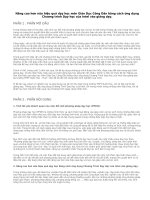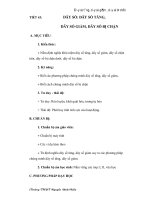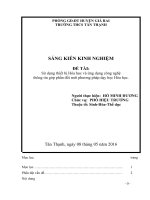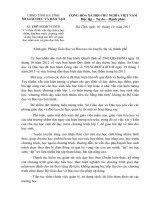Sử dụng giao thức RPL cho việc ảo hóa trong mạng cảm biến không dây
Bạn đang xem bản rút gọn của tài liệu. Xem và tải ngay bản đầy đủ của tài liệu tại đây (288.92 KB, 5 trang )
Tap chi Khoa h(»c va Cong ngh? 102 (2014) 022-026
Using RPL Routmg protocol for Virtualization of Wireless Sensor Networks
Sii dung giao thiic RPL cho ao hoa trong mang cam bi^n khong day
Thu Ngo-Quynh
School of Information and Communication Technology. Hanoi University ofScience and Technology
No. 1, Dai Co Viet Str., Hai Ba Trung, Ha Noi, Viet Nam
Received: November 01, 2013; accepted: August 25, 2014
Abstract
Virtualization of Wireless Sensor Wefivorics (WSN) is a new concept that can provide a common platfomi
upon which new federated sensor network architectures can be built, expenmented and evaluated. A
Virtualized Sensor Network (VSN) is formed by a subset of sensor nodes of a physical WSN that is
dedicated to a certain task or an application at a given time. In this paper, we investigate the requirements
that virtualization imposes on the routing procedure of the involved WSNs and propose to implement RPL
routing protocol for this virtualization purpose. In addition, we consider a special application case of
virtualization and investigate the operation of RPL in this case for establishing different instances per
application. We also present how different QoS levels can be offered by adjusting routing metncs of RPL
scheme. Our approach is validated using computer simulations.
Keywords: Virtualization, Routing protocol, Wireless sensor nehvorks.
Tom tat
Ao hda mang cam bien la mot phuang ph^p tiip c$n m&i cho phep cac t$p htyp con cac niit cim biin kit
hqp vdi nhau di thi/c hi$n mot nhiem VLI nhSt dinh trong mot khoing thd-i gian nhit dinh. Di cd the lam
duac diiu niy, vin di quan trong hien nay la thiSt ke giao thirc dinh tuyin phu hop viri Ccic ySu ciu ciia
ao hoa nhw kha nang m& rang, tinh di dong, tiit kiem nang iwqmg... Hien nay, IETF dang nghi&n ciru vi
ph^t triin giao thirc RPL - IPv6 Routing Protocol For Low Power and Lossy Network, cho ph^p truyen
IPv6 tren bo cam biin va cd nhieu tinh nang thich hap V6J ao hoa mang cam bien khong day. Trong ph^m
vi bai bao nay, chung tot thir nghiem vi$c ao hoa bkng each thiit lap cac instances khac nhau cho cac img
dicing khac nhau cua RPL, ddng th&i thay doi cac thong so cOa RPL di cung cap cac mire chat luang diet)
vij khic nhau cho cac img dung ciia ao hoa.
1. Introduction
Nowaday, WSN is working as isolated islands
and most of the sensed data is not shared among
different administrative domains. Reasons for using
dedicated sensor networks include the limited
sensing, processing and communication abilities of
the nodes, severe power constraints and most of all,
the lack of algorithms, protocols and techniques for
deploying complex sensor networks. Under a wide
vanety of conditions (large scale network of
thousands nodes, crowded urban area or difficult
terrains), independent sensor networks dedicated to a
specific task may not be the best or the most practical
deployment technique. That is why it is necessary to
deploy a WSN that is capable of sharing their
physical resources or exchanging information over
geographically isolated areas. This concept is called
Virtual Sensor Networking [I].
In principle, a Virtual Sensor Network (VSN)
consists of sensor nodes providing the ability to be
leveraged by a multitude of different
administrative
Corresponding Author, Tel- (+84) 912,528.824
E-mail: thunq@soict hust.edu vn
domains, platforms, communication protocols and
services. In a virtualized sensor networks, new
applications can be served without requiring
installing new sensors but just reusing existing ones.
For this important purpose of VSN, the most
objective of VSN is tbe resource virtualization. In
other words, network and node resources play a very
significant role for virtualization of WSN. Given dial
the VSN system will consist of heterogeneous
devices
with
different
capabilities
anil
communication resources, resource virtualization
missions are:
Communication resources/connectivity:
As the
heterogeneous devices of the system may also differ
in their communication capabilities, to optitmse the
overall network performance, routing can take
advantage
of
the
heterogeneous
neighbours
capabilities. Thus, the sensor transmission range or
the supported wireless interface will be considered as
an attribute taken into account when routing decisions
are made.
- Dynamic resource control: The (heterogeneous)
devices included in a VSN may be battery or mains
Tap chi Khoa hoc va Cong nghe 102 (2014) 022-026
powered. As the energy consumption depends on a
nmnber of operational parameters, these may be
tuned dynamically to prolong the network lifetime,
- Hardware node resources: affect the complexity of
the routing protocol that can be executed. For
example, given that security is one of the key
requirements, the implementation of trust logic can be
distributed among nodes in a proportional to
hardware resources manner.
- Security services virtualization: Different security
levels have to be supported to improve tbe probability
of reaching tbe destination for special purpose
messages. These messages may include alarm-related
messages, service discovery messages which are of
higher priority (more vital) in some applications than
regular messages carrying sensed data.
- Energy level/node status: To improve the network
reliability, in the requirements of VSN, the ability of
nodes to report their status and energy level is
included. This information is also valuable for the
routing protocol, since taking into account the
neighbor's energy levels significant reduction in the
energy consumption rate can be achieved. The fact
that it is a requirement to exchange such information
in VSN, can and will be exploited also at the routing
layer to prolong the network lifetime.
Scalability and mobility: To benefit from the
virtualization of the wireless sensor nodes and
network, all the nodes involved in the VSN have to
cooperate for trust building and routing purposes.
Although virtualization targets the reduction of the
number of devices installed in an area by exploiting
already installed sensors, m this imcontrolled
environment, the number of nodes in the
neighbourhood can fluctuate. Thus, it is mandatory
for the relevant protocols to support both scalability
and mobility.
From this point of view, virtualization of WSN
aims at exploiting
the dynamic
symbiotic
relationships of application and virtualization
requirements that will produce a carefully crafted
platform of sensor nodes [2] [3], In other words, a
complex and heterogeneous large scale VSN imposes
requirement
of
energy
efficiency,
seamless
connectivity, operational reliability and security [4]
[5]. In order to satisfy this requirements,
virtualization process will influence the design
support of layer 3 (routing) of the protocol stack
significanfly.
In
addition,
when
designed
appropriately, VSN routing protocol can affects
achieved quality of service (QoS) for different
applications. Furthermore, we realize that over a
same WSN infrastructure, different applications
require different QoS levels but satisfymg this is not
always a straightforward task. In order to overcome
this problem, we can think about choosing
appropriate routing metrics of the routing protocol for
handling traffic of these applications differently.
A routing protocol satisfying the above
requirements of virtualization is IPv6 Routing
Protocol for LLNs (RPL) [6], RPL constructs
Directed Acyclic Graphs (DAG) and defines the rules
based on which every node selects a neighbor as its
parent in the DAG, thus forming a tree. To cover the
diverse
requirements
imposed
by
different
applications, ROLL has specified in [7] a set of link
and node routing metrics and constraints (which can
be static or dynamic) suitable to Low Power and
Lossy link Networks to be used in RPL, The RPL
protocol offers an additional feature which is very
crucial for supporting virtual networks over LLNs: it
supports the construction of multiple routing trees
with the same or different destination (root) node
based on different routing metrics, which form the socalled routing instances. In other words, different
routing paths firom the sensor nodes towards the sink
node can be constructed to service different
applications optimizing a different performance
aspect each time. For example, for e-health
application, high reliability and low latency are
required while for temperature and condition control
applications, extended network lifetime is far more
important than reliability. For this reason, we
anticipate that the adoption of RPL protocol brings
important benefits when Wireless Sensor Network
virtualization comes into the scene.
Routing design plays an important role for VSN
but to the best of our knowledge, the research of
impact of virtualization on routing, especially on RPL
protocol is rarely investigated recently. In addition,
there is also no research study that proposes a
virtualized routing solution based on RPL that can
provide different QoS for different applications in
VSN. In this paper, we consider a special case of
virtualization and investigate the operation of RPL in
this case for establishing different instances per
application. We also present how different QoS levels
can be offered by adjusting routing metrics of RPL
scheme. Our approach is validated using computer
simulations.
The rest of the paper is organized as follows: in
section I! we describe the steps that need to be carried
out for virtualization purpose of an application that
monitors the crossing of animal and sliding of rock.
In section III we provide simulation results to show
how the different adopted metrics can lead to
different performance aspect optimization over the
same sensor network. Finally, conclusions are dra-wn
in section IV.
Tap chi Khoa h^c va Cdng nghe 102 (2014) 022-026
2. RPL Protocol
their ranks are set up equal to received rank plus 1.
In this paper, we consider here a geographical
application case of two VSNs for monitoring the
crossing of animal (VSNi) and sliding of rock
(VSN2), where virtualization requires an efficient use
of resources.
Based on this information, nodes can select their
parents, siblings and prefer-parent.
Fig. 1. Rock sliding and animal crossing [8]
Step 3. Root broadcasts DIG message in order to
create second instance. Sinular to the first step, root
continues to broadcast DIO message to all its
neighbors in both VSNi and VSN2 for establishing
second instance with the following information:
Fig. 3. Operation of 2"'' step
More concretely, we will examine how RPL
operates in order lo establish two instances for these
two applications: one instance for rock sliding and
one instance for animal crossing over a same physical
sensor infrastructure.
In order to accomplish this mission, RPL needs
to perform foilowmg steps:
Rankld=!. Instanceld=2
andDAGId=l.
This step is similar to tbe step when establishing
the first instance.
Step 1: Root broadcasts DIO message in order
to establish DAG for the first instance. In this step,
instanceld^l
the DIO message contains Rankld^I.
and DAGId=l and only nodes belong to VSNi can
receive this DIO message.
All nodes that receive this message will join to
instance numbered 1, set up root as their preferparent
and also set up their ranks according to the following
equation:
Rankld^Rankld
of root + /
Fig. 4. Operation of 3"* step
Step 4. Nodes continue to broadcast DIO
message of the second instance in order to select
parents, siblings and prefer-parent.
Fig. 2. Operation of P ' step
These nodes continue to broadcast DIO message
to their neighbors with the same instanceld and
DAGId but the value of Rankid changed to their
ranks.
Fig. 5. Operation of 4 * step
Step 2. Nodes continue to broadcast
message for the first instance.
DIO
When their neighbors receive DIO message,
Step 5. This step helps to transmit data to the
root. When received DATA message, root will check
all links that connect root to its neighbors. If all these
Tap chi Khoa hoc va Cong nghf 102 (2014) 022-026
links are dead, the simulation is terminated. If no,
nodes will continue lo transmit data lo the root. In the
following figure, instance 1 is presented by black line
while instance 2 is presented by orange line. More
concretely, instance 1 consists only nodes belong to
VSNi while instance 2 consists nodes belong to both
VSNi and VSN2.
3.1 Scenario 1
The first scenario will contain only one instance
that covers nodes of both VSNi and VSN2, but the
routing metrics for this instance is hop count or node
energy. We evaluate the network lifetime of this
scenario in these two cases in order to know which
routing metric can provide better network lifetime.
The following figure plots the number of dead nodes
in two cases.
Fig. 6. Operation of 5* step
Step 6. This step is for updating rank, parents,
sibling and prefer-parent. Periodically, nodes need to
update information relating rank, parents, sibling and
prefer-parent by sending DIO message.
Fig. 7. Operation of 6"" step
Fig. 8. Number of dead nodes
From this figure, we realize that using hop count
as routing metric provides higher number of dead
nodes than energy. It can be explained easily because
when using hop count, routing decision of RPL does
not pay attention at residual energy of sensors. The
foilowmg figure presents network lifetime of the
second case when using node energy for routing
metric of RPL. Clearly, the first node dead parameter
of case using node energy is 188 rounds, and much
more better than the first node dead parameter of case
using hop c o u n t - 61 rounds.
3 . Performance evaluation
In this section, we consider two routing metrics:
hop count and residual energy and evaluate network
lifetime of VSNs when setting these metrics for
object fimclions of RPL. Finally, we examine a
topology, where RPL needs to provide different
quality of service levels for these sliding rock and
crossing animal applications by using the above
routing metrics (hop-count and residual energy).
From the case descnbed m the above section,
we realize that VSNi contains nodes that are
distributed in a mountainous area in order to monitor
the animal crossing while VSN2 monitor the sliding
of rock in a more dangerous area. Because of
different geographical conditions of these two VSNs,
it is easier to remove or change the sensors of VSNj
than the sensors of VSN2 or it is more important to
maintain the network lifetime of VSN2 than VSNi.
This problem can be resolved by providing different
object fimctions for RPL. Tbe above steps of RPL
scheme were implemented in OMNET++ simulator.
We simulate here two VSNs, each has hundred nodes
that are distributed randomly in an area of
JJ
Fig. 9. Network lifetime of P ' scenario
3.2 Scenario 2
The purpose of this scenario is to provide
different QoS levels for two applications: rock sliding
and animal crossing through virtualization. From the
previous scenario, we realize that for providing VSN2
better network lifetime, we can select node energy as
routing metric for RPL, while VSNi can use hop
count for object function of RPL In this scenario,
instance numbered 1 is transmitted within VSN| only
while instance numbered 2 is transmitted within both
V S N I and VSN2. We calculate number of dead nodes
of two VSNs and present in the following figure:
Tap chi Khoa hoc v^ Cong nghf 102 (2014) 022-026
J
Fig. 10. Number of dead nodes of 2'"' scenario
J
Fig. 11. Network Hfetime of 2""* scenano
From the above figiu-e, we realize that the
number of dead nodes VSN? is smaller than VSNi.
More concretely, the network lifetime of two VSNs
are presented in the following figure by two metrics,
first node dead and total live round. Total live round
is the network operation time until all nodes are out
of energy and this metric is calculated by number of
rounds.
First node dead is the number of round when
first node in the network runs out of energy.
The first node dead of VSNi is after 60 rounds,
while for VSN2 it is after 114 rounds. The total live
round of VSNi is only 174 rounds while the total live
roimds of VSN2 is 322. Obviously, the network
lifetime of VSN2 is better than VSN| or the quality of
service of VSN2 is better than VSNi. This feature can
be explained because instance I of VSNi utilizes hop
count as routing metric for RPL object fimction,
while instance 2 of VSN2 covers nodes of both VSNs
and utilizes node energy for RPL object fimction.
That is why it is possible to use routing metrics of
RPL for providing different quality of service levels
for different applications in case of virtualization.
4. Conclusion
In this paper, we investigate the impact of
virtualization on routing procedure of WSN. We also
analyze different QoS requirements of application in
geographical context and provide this QoS
differentiation by setting object fiinctions for the RPL
protocol. Via simulation, the QoS requirements are
satisfied by using hop count and node energy for
object function of RPL protocol.
References
[I] Islam, M.M,; Hassan, M.M.; Lee, G.-W.; Huh, E.-N A
Survey on Virtuahzahon of Wueless Sensor Networks.
Sensors, 12(2012)2175-2207.
[2] M. M. Islam, M M Hassan, and E, N. Huh,
"Virtualization in wireless sensor network: challenges
and opportunities," in Proceedings of the 13th
International Conference on Computer and Information
Technology (ICCIT '10), Dhaka, Bangladesh,
December 2010
[3] S. Kabadayi, A. Pridgen, and C Julien, "Virtual
sensors: abstracting data from physical sensors," in
Proceedings of the International Symposium on a
World of Wireless, Mobile and Multimedia Networks
(WoWMoM '06), Buffalo-Niagara Falls, NY, USA,
June 2006, pp, 587-592,
[4] S. Kabadayi, A, Pridgen, and C. Julien, "Virtual
sensors: abstracting data from physical sensors," in
Proceedings of the International Symposium on a
World of Wireless, Mobile and Multimedia Networks
(WoWMoM '06), Buffalo-Niagara Falls, NY, USA,
June 2006, pp, 587-592
[5] J. H. Shin and D, Park, "A virtual infi:astructure for
large-scale wireless sensor networks," Computet
CoramunicaUons, 30 (2007) 2853-2866.
[6] IPv6 over Low-Power Wireless Personal Area
Networks (6LoWPANs): Overview, Assumptions,
Problem
Statement,
and
Goals,
https,//datatracker.ietf.org/doc/draft-ietf-6lo-wpanproblem/
[7] RPL: IPv6 Routing Protocol for Low power and Lossy
Networks, http.//tools.ietforg/hmil/draft-ietf-roll-rpl-l9
[8] Md. Motaharul Islam, Eui-Nam Huh, "Virtualization in
Wireless
Sensor
Network:
Challenges and
Oppominities", Joumal of Networks, 7 (2012) 412-418,









